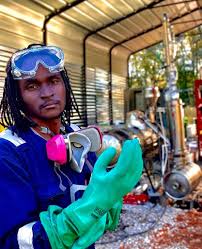In a world drowning in plastic pollution—over 400 million tons produced annually, with only 9% recycled—innovation often comes from the unlikeliest places. Enter Julian Brown, the 22-year-old Atlanta-based inventor whose breakthrough fuel, Plastoline, is turning heads, sparking debates, and trending across social media. On October 4, 2025, Brown made history by powering a high-performance Dodge Scat Pack muscle car entirely on fuel derived from everyday plastic waste, drawing a crowd of over 1,000 onlookers in Atlanta. If you’re searching for “Julian Brown inventor” or “plastic to fuel trending,” this is the story that’s capturing the internet’s imagination—and for good reason.
From Backyard Experiments to Global Buzz: Julian Brown’s Journey
Julian Brown isn’t your typical Silicon Valley tech bro. A self-taught engineer from metro Atlanta, Brown started tinkering with ideas in high school, driven by a passion to solve two massive problems: plastic pollution clogging oceans and landfills, and the world’s reliance on fossil fuels. At just 17, he built his first prototype of a solar-powered microwave pyrolysis reactor in his backyard. Pyrolysis, for the uninitiated, is a process that heats materials in an oxygen-free environment to break them down into usable components—think of it as recycling on steroids.
Over five grueling years, Brown iterated through five prototypes, facing setbacks like a near-fatal explosion that left him with second-degree burns. Undeterred, he funded his work through GoFundMe campaigns, raising over $30,000 from supporters who believed in his vision. Today, through his company NatureJab, Brown has refined Plastoline into a 110-octane, clean-burning fuel that rivals traditional gasoline in performance while emitting fewer pollutants than standard diesel, according to independent lab tests.
What sets Brown’s approach apart? His reactor uses solar-powered microwaves to heat unsorted plastic waste (like bottles and bags) to 400–600°C, vaporizing it into hydrocarbons that condense into gasoline, diesel, and even syngas for reuse. No sorting required, no external combustion needed—it’s efficient, scalable (in theory), and eco-friendly.
The Historic Demo: Powering a Muscle Car with Trash
The moment that catapulted Julian Brown into trending status happened on October 4, 2025, at a Duluth, Georgia, Nissan dealership. In front of a roaring crowd, Brown poured Plastoline into the tank of a stock 2023 Dodge Scat Pack—a beast with a supercharged 6.2L V8 engine—and fired it up. The car didn’t just start; it revved, burned rubber in a burnout, and ran flawlessly, no modifications needed.
Videos of the event exploded online, amassing millions of views. “HUMANITY WE DID IT!” Brown posted on X (formerly Twitter), sharing a photo of the triumphant scene. Celebrities and influencers like Isaac Hayes III hailed it as “Black brilliance, Black science, and Black innovation at its finest,” emphasizing Brown’s role as a young Black inventor challenging industry giants. The demo wasn’t just a stunt; it proved Plastoline could power real vehicles, potentially processing 24–30 tons of waste daily into revenue-generating fuel.
Why Julian Brown’s Plastoline Could Change Everything
Imagine a future where plastic bags fuel your commute, reducing landfill waste by up to 80% and cutting emissions in the process. Brown’s invention aligns perfectly with global pushes for circular economies and zero-waste goals. It could disrupt the $4 trillion oil industry and waste management behemoths, turning environmental headaches into economic wins—potentially generating millions in graphene byproducts alone.
Supporters see Brown as a modern-day hero, echoing inventors like Nikola Tesla whose ideas were once dismissed. Posts on X buzz with calls to “protect him at all costs,” fearing corporate sabotage from Big Oil. Even Florida gubernatorial candidate Moe Dimanche pledged statewide adoption if elected.
The Skeptics: Is Plastoline Truly Revolutionary?
Not everyone is sold. Critics point out that pyrolysis isn’t new—it’s been around since the 1960s, with commercial plants in Japan and India since 2005. Wikipedia even labels Brown a “social media personality” rather than a groundbreaking researcher, noting potential carcinogens in pyrolysis fuels.
Challenges like scalability, energy efficiency, and regulatory hurdles loom large. Brown’s system, while innovative in its solar-microwave twist, may not yet be ready for mass production without further testing. Rumors of Brown’s “disappearance” in July 2025 were debunked by his mother, but they highlight the high stakes of challenging entrenched industries.
Julian Brown’s Legacy: Fueling Hope in a Polluted World
Love it or question it, Julian Brown’s Plastoline demo has ignited a conversation about sustainable energy that’s impossible to ignore. As a young Black inventor from Atlanta, he’s proving that solutions to the world’s biggest problems can start in a backyard with grit, faith, and a microwave. Whether it scales to industrial levels or inspires the next wave of innovators, Brown’s story is a reminder: trash today could power tomorrow.
What do you think—game-changer or hype? Follow Julian Brown on X (@Naturejab) for updates, and share your thoughts in the comments. If you’re passionate about clean energy innovations like plastic-to-fuel tech, subscribe for more stories on trending inventors reshaping our future.
Have any thoughts?
Share your reaction or leave a quick response — we’d love to hear what you think!

